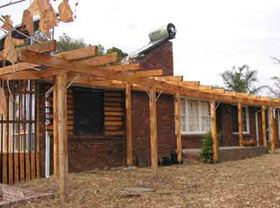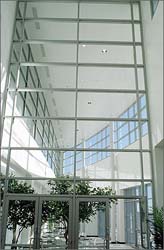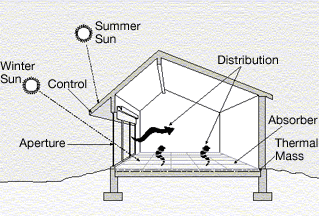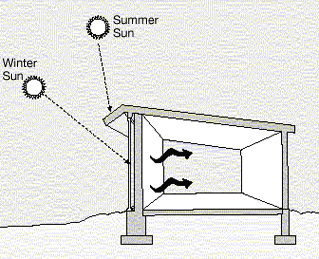passive solar design
Passive solar design, also called climatic design, is a design approach that uses structural elements of a building to heat and cool a building without the use of mechanical equipment. Passive solar design calls for careful consideration of factors such as local climate and solar energy resources, building orientation, and landscape features.
 |
The principal elements of passive solar design include proper building orientation, proper window sizing and placement and design of roof overhangs to reduce summer heat gain and ensure winter heat gain, and proper sizing of thermal energy storage mass (for example, masonry tiles). The heat is distributed primarily by natural convection and radiation, though fans can also be used to circulate room air or ensure proper ventilation.
Unlike active solar heating systems, a passive design does not involve the use of mechanical and electrical devices, such as pumps, fans, or electrical controls, to circulate the solar heat. Buildings designed for passive solar incorporate large south-facing windows and construction materials that absorb and slowly release the sun's heat. The longest walls run from east to west. In most climates, passive solar designs also must block intense summer solar heat. They typically incorporate natural ventilation and roof overhangs to block the sun's strongest rays during that season.
 |
| Effective use of daylighting and passive solar heating
in the Solar Energy Research Facility in Golden, Colorado. (Credit:
Warren Gretz)
|
Daylighting takes advantage of natural sunlight, through well-placed windows and specialized floor plans, to brighten up a building's interior.
Passive solar design can be used in most parts of the world. If designed by an experienced passive solar architect, buildings using passive solar design principles need not cost more up front than conventionally designed buildings. And when they do, the savings in energy bills quickly pay for themselves.
How passive solar design works
 |
| Elements of passive solar design, shown in a direct
gain application
|
Every passive solar building includes five distinct design elements:
There are three basic passive solar designs for heat regulation, each of which incorporates these five elements in different ways.
Direct gain
This the simplest passive design technique. In direct gain, sunlight enters a building through an opening – usually south-facing windows. It then strikes the building's thermal mass – usually dark-colored masonry floors and/or walls in the interior space that absorb and store the solar heat. At night, as the building cools, heat stored in the floors and walls warms the rooms.
Trombe wall (indirect gain)
In the Trombe wall design, a dark-colored wall is placed between a building's south-facing windows and its living or working space. The wall absorbs solar heat through radiation, stores it, and then releases it into the building when the indoor temperature falls below that of the wall's surface.
 |
| Passive solar design using a Trombe
wall
|
Sunspace (isolated gain)
This design uses a separate solar room (solarium) to store solar heat. A sunspace can be built as part of a new building or as an addition to an existing one. Sunspaces also require a thermal mass to store heat. This stored heat is distributed throughout the building via ceiling and floor-level vents, windows, and doors, sometimes with the addition of fans.
Daylighting requires windows that are placed on or near a building's roof, such as skylights. High-level windows (see clerestory) and skylights can allow sunlight to reach throughout a building – including north-facing rooms and upper levels. This typically requires an open floor plan – one that incorporates very few full walls. Effective use of daylighting reduces the need for electric light.
Advantages of passive solar design
Passive solar design is highly energy efficient, reducing a building's energy demands for lighting, winter heating, and summer cooling. Energy from the sun is free. Strictly passive designs capture it without additional investments in mechanical and electrical active solar devices such as pumps, fans and electrical controls.
Passive solar design also helps conserve valuable fossil fuel resources so that they can be directed toward other uses. And it saves money. Incorporating passive solar design elements into buildings and homes can reduce heating bills by as much as 50%. Daylighting, a component of many passive solar designs, is one of the most cost-effective means of reducing energy usage in buildings.
A well-designed and built passive solar building does not have to sacrifice aesthetics either. It can be as attractive as conventionally designed buildings and still save energy and money.
Passive solar design also reduces greenhouse gases that contribute to global warming because it relies on solar energy, a renewable, nonpolluting resource.
Disadvantages
There are few disadvantages to passive solar design and daylighting. With the help of experienced passive solar designer architects and builders, passive solar design costs little more than conventional building design and saves money over the long run.
But in areas where experienced solar architects and builders are not available, construction costs can run higher than for conventional homes, and mistakes can be made in the choice of building materials, especially window glass. Passive solar homes are often built using glass that, unfortunately, rejects solar energy. Such a mistake can be costly. Choosing glass for passive solar designs isn't easy. The right glass choice depends on which side of the building (east, west, north, or south) the glass is installed and the climate in which you are building.
In addition, room and furniture layouts need to be planned carefully to avoid glare on equipment such as computers and televisions.
And along with daylighting comes heat. During the summer or in consistently warm climates, daylighting could actually increase energy use in a building by adding to its air-conditioning load.
Applications
In the case of the United States, for example, passive solar design and daylighting principles can be applied to buildings in almost any region except Alaska. In hot climates, the design mitigates the sun's heat; in cold climates the design takes advantage of it. However, passive solar heating tends to work best and be most economical in climates with clear skies during the winter heating season and where conventional heating sources are relatively expensive.
Passive solar buildings have been constructed as far north as Maine and as far south as Florida. In the United States, the design principles are most commonly used in residences because passive solar design works best in smaller buildings. But some passive solar design and daylighting applications also are used in commercial construction. For example, the Solar Energy Research Facility at the National Renewable Energy Laboratory, a Department of Energy national laboratory located in Golden, Colorado, has incorporated a sunspace for passive solar heating into its building (see photo above).
